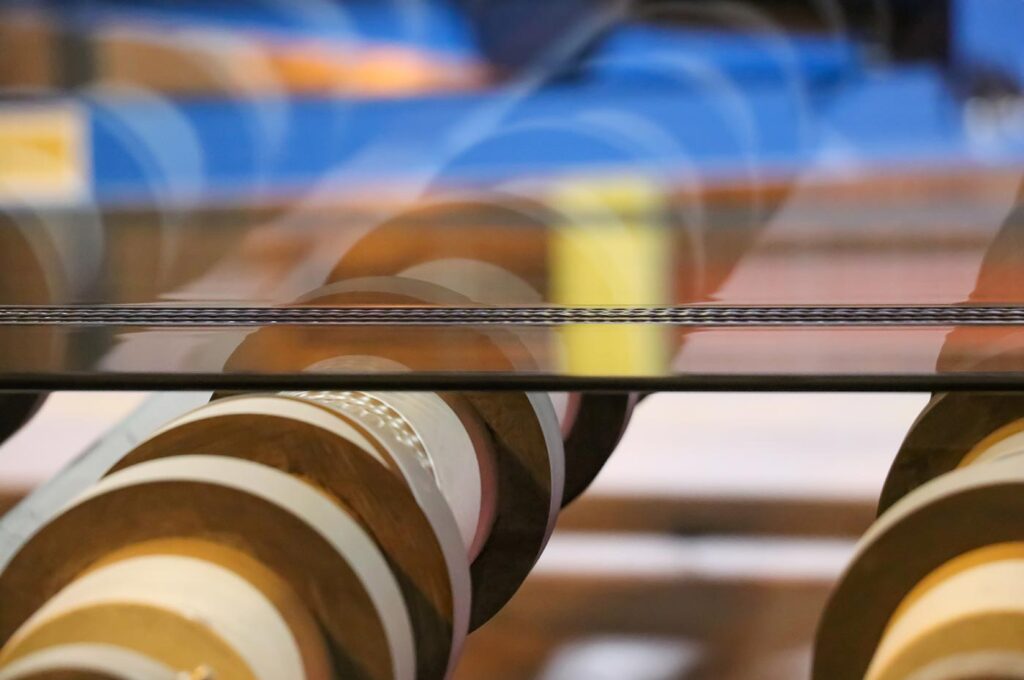The Role of Glass in 5G Technology: Manufacturing Challenges and Solutions
Glass: The Unsung Hero of 5G Infrastructure
5G technology demands materials that can support high-frequency signals with minimal loss. Glass, particularly silicate glass, exhibits low dielectric loss, a smooth surface, and high resistance to process chemistry, making it an ideal candidate for 5G applications.[1] Its insulating properties ensure low-loss performance, especially at millimeter-wave frequencies, which are crucial for 5G’s high-speed data transmission.
Moreover, advancements in manufacturing have enabled glass to be produced in thin, large-area formats, facilitating fine line spacing and miniaturization—key factors in modern electronic devices. These attributes position glass as a vital component in antenna substrates, filters, and other critical 5G hardware.[2]
Manufacturing Challenges in Integrating Glass into 5G Technology

Handling and Processing Thin Glass
Producing ultra-thin glass substrates suitable for 5G applications requires precision handling and processing techniques.[3] Thin glass is inherently fragile, posing risks during manufacturing processes such as cutting, drilling, and etching. Developing robust handling strategies, like temporary bonding to support wafers, is essential to prevent breakage and ensure compatibility with existing manufacturing infrastructure.
Achieving High-Volume Manufacturing (HVM)
Transitioning from small-scale demonstrations to high-volume manufacturing of glass components for 5G is a significant hurdle. The industry must adapt current production lines or develop new ones to accommodate the unique properties of glass. This includes addressing challenges related to scalability, yield rates, and cost-effectiveness to meet the growing demand for 5G infrastructure components.
Ensuring Reliability and Durability
Glass components in 5G devices must withstand various environmental stresses, including thermal shocks and mechanical impacts.[4] Ensuring that glass substrates maintain their integrity and performance over time is crucial for the reliability of 5G networks. This necessitates rigorous testing and the development of glass compositions tailored to endure such conditions.
Solutions and Innovations in Glass Manufacturing for 5G
Advanced Glass Compositions
Developing specialized glass materials that combine durability with the necessary electrical properties is a focal point. Innovations in glass chemistry aim to produce substrates that are both robust and capable of supporting high-frequency 5G signals.
Precision Manufacturing Techniques
Investing in cutting-edge manufacturing technologies, such as laser processing and chemical strengthening, allows for the precise fabrication of thin glass components. These techniques enhance the mechanical strength of glass, reducing the risk of damage during production and application.
Collaborative Industry Efforts
Collaboration among glass manufacturers, equipment suppliers, and research institutions is vital. By sharing knowledge and resources, the industry can develop standardized processes and equipment tailored to the unique requirements of glass in 5G applications.
Highlighting Industry Leaders: Corning Incorporated
One notable member of the Glass Manufacturing Industry Council (GMIC) leading the charge in this domain is Corning Incorporated.[5] With a legacy of innovation in materials science, Corning has been at the forefront of developing glass solutions that meet the stringent demands of 5G technology. Their expertise exemplifies how dedicated research and development can drive the industry forward.

The Future of Glass in 5G Technology
As 5G networks continue to expand globally, the demand for materials that can support higher frequencies and faster data rates will intensify. Glass, with its unique properties, is poised to play an increasingly prominent role in this evolution. However, realizing its full potential hinges on the industry’s ability to address current manufacturing challenges through innovation and collaboration.

The Glass Manufacturing Industry Council (GMIC) serves as a pivotal platform in this endeavor, bringing together stakeholders from various sectors to promote the interests and growth of the glass industry. By facilitating education, research, and industry advocacy, GMIC ensures that glass manufacturers are well-equipped to meet the demands of 5G technology and beyond.
In conclusion, the integration of glass into 5G technology presents both significant opportunities and challenges. Through concerted efforts in research, manufacturing, and industry collaboration, the glass industry can overcome these hurdles, solidifying glass’s role as an indispensable component in the 5G era.
Sources
- “The Manufacturing Institute 5G Study”[1] – The Manufacturing Institute
- “Glass for 5G Applications”[2] – American Institute of Physics
- “Meridian”[3] – Meridian
- “Enabling Low-Loss Thin Glass Solutions”[4] – Mosaic Micro
- “Glass Manufacturing Industry Council (GMIC)”[5] – GMIC
 JOIN GMIC
JOIN GMIC